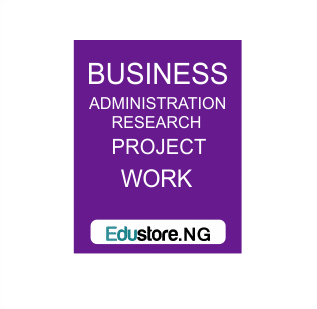The Effect Of Human Resource Management On Organisational Performance
ABSTRACT
The most valued asset of every organization is its Human Resources, which ensures the maximum utilization of employees performance towards the attainment of organization’s pre-determine goals and objectives .The study examine the effect of Human Resources Management on organizational performance using Viju Industry Nigeria PLC, Igbesa Ogun State as a case study. The main objective of the study was to determine the relationship between human resource management and organizational performance. More specifically, the objective of the study was to examine the relationship between human resources management and employee productivity, to find out the relationship between human resources management and competitive advantage. A sample size of hundredth (100) employees of Viju Igbesa through stratified sampling technique with specific futures of the Study population. Relevant data was collected through the use of questionnaire constructed by the researcher to measure the effect of human resource management on organizational performance under study. A descriptive analysis was done and hypotheses were tested at 5% level using Karl person product moment correlation coefficient test statistics. The hypotheses are thus, there no is significant relationship between human resource management and employee productivity, there is significant relationship between human resource management and employee productivity. The result indicates there is very strong positive correlation between human resource management and employee productivity. It is therefore recommended that Viju industry Igbesa should ensure proper managing, motivation, training and development of their personnel’s.
TABLE OF CONTENTS
CONTENTS PAGES
TITLE PAGE………………………………………………………………………..
CERTIFICATION…………………………………………………………………..
ACKNOWLEDGEMENT ………………………………………………………….
DEDICATION………………………………………………………………………
ABSTACT……………………………………………………………………………
TABLE OF CONTENTS……………………………………………………………
CHAPTER ONE………………………………………………………………….
INTRODUCTI ON……………………………………………………………….
- Background of the study……………………………………………
1.1 Statement of research problem……………………………………..
1.2 Statement of research objective……………………………………
1.3 Statement of research question……………………………………
1.4 Statement of research hypothesis……………………………………
1.5 Significant of the study……………………………………………….
1.6 Scope of the study……………………………………………………
1.7 Limitation of the study……………………………………………….
1.8 Operational definitions of terms……………………………………..
1.9 Historical background of the study………………………………….
CHAPTER TWO……………………………………………………………………..
LITERATURE REVIEW……………………………………………………………
- INTRODUCTION………………………………………………………………
- CONCEPTUAL FRAME WORK……………………………………….
2.1.1 CONCEPT OF HUMAN RESOURCE MANAGEMENT……………….
- FUNCTION OF HUMAN RESOURCE MANAGEMENT……………………
2.1.3 CHALLENGES OF HUMAN RESOURCE MANAGEMENT IN NIGERIA…
2.1.3 CHALLENGES OF HUMAN RESOURCE MANAGEMENT IN NIGERIA……
2.1.4 HUMAN RESOURCE MANAGEMENT AND EMPLOYEE PERFORMANCE
2.1.5 IMPORTANCE OF HUMAN RESOURCE MANAGEMENT ON ORGANISATIONAL PERFORMANCE……………………………………
2.3 EMPERICAL REVIEW………………………………………………….
2.4 LIMITATION OF LITERATURE REVIEW……………………………..
CHAPTER THREE……………………………………………………………
RESEARCH METHODOLOGY………………………………………………..
3.0 INTRODUCTION……………………………………………………………
3.1 RESEARCH DESIGN…………………………………………………………
3.2 POPULATION OF THE STUDY………………………………………………
3.4 DATA COLLECTION INSTRUMENTS……………………………………….
3.5 ADMINISTRATION OF RESEARCH………………………………….. INSTRUMENTS……………………………………………………………….
3.6 VALIDITY OF THE RESEARCH INSTRUMENTS……………………..
3.7 RELIABILITY OF RESEARCH INSTRUMENTS…………………………
3.8 ADMINISTRATION OF RESEARCH INSTRUMENTS ………………….
2.9 METHOD OF DATA ANALYSIS…………………………………………….
CHAPTER FOUR………………………………………………………………………..
DATA ANALYSIS AND DATA PERSENTATION
4.0 INTRODUCTIO
4.1 SEX DISTRIBUTION OF RESPONDS
4.2 AGE DISTRIBUTION OF RESPONDS
4.3 RELIGION DISTRIBUTION OF RESPONDS
4.5 MARITAL STATUS OF THE DISTRIBUTION OF RESPONDS
4.6 HYPOTHESIS ONE
4.7 HYPOTHESIS TWO
CHAPTER FIVE
Questionnaire
References
CHAPTER ONE
INTRODUCTION
1.1 BACKGROUND OF THE STUDY
In the last ten years, organizations especially in Nigeria have been hit with the undisputable fact that the creation of competitive advantage lies in people. Organizations have increasingly recognised the potential for their people to be a source of competitive advantage. Not too long ago, so called Human Resource functions was the preserved of “personnel managers” whose duties were to select, appraise, promote, demote and recruit. These superficial duties could be perform by any manager, it therefore never seemed necessary employ an expert in the form of Human Resource Manager let along create a whole department dedicated to Human Resource Management issues and its impact on organizational performance. The emphasis on traditional and socio-culture issues injected an element of subjectivity in personnel manager functions such as recruitment, selection, compensation and demotion. In today’s competitive and changing business world, organizations especially in the service industry need to ensure maximum utilization of their resources to their own advantage; a necessity for organizational survival. Studies have shown that organizations can create and sustain competitive position through management of substitute, rare, valued and inimitable internal resources (Barney, 2001). Human resource management has translated from policies that gather dust to practices that produce results. Human resource management practices has the ability create organizations that are intelligent, flexible and competent than their rivals through the application of policies and practices that concentrate on recruiting, selecting, deployment, training skilled employees and directing their best efforts to cooperate within the resource bundle of the organization. This can potentially consolidate organisations performance and create competitive advantage as a result of historical sensitivity of human resource and the complex of policies and practices that rivals may not be able to imitate or replicate their diversity and dept. lately; organisations are focused on achieving superior performance through the best use of talented human resources as strategic assets. Human resource management policies or strategies must now be aligned to business strategies for organizational success. No matter the amount of technology and mechanization developed, human resource remains the singular most important resource of any success-oriented organisation. After all, successful businesses are build on the strength of exceptional people. Human resource management has gained significance academically and business wise and can therefore not to be related to the background or left in the hands of non-experts. Attention must be paid to how human resources in organisation spend considerable time and resources to select. Armstrong (2009) defines Human Resource Management (HRM) as a strategic and coherent approach to the management of organisation’s most valued asset; that is, the people working there who individually and collectively contributes to the achievement of its objectives. Moreover, Human resource management practices can be defined as a set of organisationals activities that aim at managing a pool of human capital and ensuring that this capital is employed towards the achievement of organizational objectives (Wright and Boswell, 2002). The adoption of certain bundles of human resource management practice has the positively of influencing organization performance by creating powerful connections or to detract from performance when certain combination of practice are inadvertently placed in the mix (Wagar and Rondeau, 2006). So if think human resource management as just the service that any employee can provide recruitment, selection, performance appraisal, compensating employees, training and development, then we rather would have to take the backseat for those who understand the influence of human resource management has on corporate performance to take the center stage. Research has recorded that there is positive relationship between human resource management practice and corporate performance. Thus in order to stimulate corporate performance, management is required to train and develop talented skilled employees who are capable of performing their jobs successfully (Klein, 2004). Achieving better corporate performance requires successful, effective and efficient exploit of organisations resources and competences in order to create and sustain competitive position locally and globally. Human resource management policies on selection, performance appraisal, deployment, compensation, promotion, incentives, involvement, communication, participation, work design, employment security, training and development, etc, most be formulated and implemented by human resource management specialist with the help of line managers to achieve the following out comes; competence, cooperation with management ,cooperation among employees, motivation, commitment, satisfaction, retention, presence, etc. For business to survive , human resource management should be given its rightful place of relevance in any organisation and not left in the hands of line managers who neither have the expertise nor the time and space to carry out the enormous functions of human resource manager. Therefore the study has determined the effect of human resource management on organizational performance in Viju industry Igbesa.
1.2 STATEMENT OF THE PROBLEM
Human resource management has made significant inroads into the Nigeria corporate world. It is common to see large organisation in Nigeria set up a whole department for the sole aim of managing human resources and hire experts in the field to be in charge of human resource management cold. The enormous benefits of properly managing human resource cannot be over emphasizes. However, the majority of the organisations in Nigeria are yet to catch the human resource management cold. Inappropriate human resource policies and practice of some these banks can be attributed to non-existence of human resource management specialist or departments. Research has establish a significantly a positive relationship between human resource management and organizational performance. Most of these organistions do not realize the impact of properly managing its human resources and therefore leave polices in the hands of line managers and board of directors who are non-human resource manager’s experts to implement and enforce strategies, policies, processes, programmes, and practices. The value of properly managing human resource is lost to such organisations which cannot consequently impede or their growth. Management of people and acquiring competitive edge are two key challenges facing most organisations. How you manage the people and how you mange the risk determines how competitive a firm may be within its industry. Gaining competitive edge may not be possible without efficient and skilled manpower. In acquiring competitive advantage, Viju must try to distinguish them by creating their own niches or images, especially in transparent situations with a high level of competitiveness. In coming times, the very survival Viju would depend on customer’s satisfaction. Those who do not meet the customers’ expectations will find survivals difficult. Organisation especially must articulate and emphasize the core value to attract and retain certain customers segment. A sound reliable, innovative, close and socially responsible workforce need to emphasize upon in order to acquire competitive advantage. Human resource management has into oblivion to most of the organisations saw the role and impact of human resource management on performance and worked towards properly managing their manpower. It is in the face of this existing state that the researcher has established the impact of human resource management on organizational performance.
1.3 STATEMENT OF RESEARCH OBJECTIVES
The main objective of this study is to examine the effect of human resource management on organizational performance. The specific objectives are:
- To examine the relationship between human resource management and employee productivity.
- To find out the relationship between human resource management and competitive advantage.
- To determine the various human resource management practices that ensures organizational growth.
- To serve as reference point for researcher, policy makers and students.
1.4 STATEMENT OF RESEARCH QUESTIONS
The following questions are relevant to this study:
- What is the relationship between human resource management and employee productivity?
- What is the relationship between human resource management and competitive advantage?
- What are those various human resource management practices that ensures organizational growth?
1.5 STATEMENT OF RESEARCH HYPOTHESIS
H01: There is no significant relationship between human resource management and employee productivity.
Ha1: There is significant relationship between human resource management and e mployee productivity.
H02: There is no significant relationship between human resource management and competitive advantage.
Ha2: There is significant relationship between human resource management and competitive advantage.
1.6 SIGNIFICANCE OF THE STUDY
The study has made the organisation to understand human resource management is an integral function of which determines the continuous existence of an organisation and the accomplishment of individual objectives by every employee. It has made the organisations to understand that effective and efficient management workforce is a means to acquire competitive edge within their industry. It has serve as a source of policy guidance to Viju and provide necessary incentives for increasing productivity, it has also help enlighten the management on the need and importance of having effective human resource management practice in the organisation. Organisational productivity culminating into effectiveness, efficiency, success and development depends on the maximum utilization of human resource. Notwithstanding the level of organistions technology is primarily a labour intensive manufacturing sector. Hence it will not be possible for the organisation to sustain productivity unless human resource management is given prime importance. Because technology is only an aid to human effort and not to substitute workforce. It is recognized fact that human resource management occupies a unique and sensitive position in every organisation. Therefore this study has made Viju industry Igbesa, Ogun state to realize the impact and role of human resource management. The study will serve as a source of knowledge for future researchers who are willing to embark on similar study.
1.7 SCOPE OF THE STUDY
The study has examined the effect of human resource management on organisational performance, using Viju Industries Igbesa, Ogun state as a case study. It has revolved round brining into reality how the concept of human resource management serves as determinant for organisational performance, employee productivity and competitive advantage by examining the relationship existing within them.
1.8 LIMITATION OF THE STUDY
The challenges that was impede on the successful completion of this research work was financial constraint, time constraint, non-availability of relevant literature, respondents attitude was poor and the questionnaire was not recovered on time ant it wasn’t complete. The researcher would have extended the study.
1.9 OPERATIONAL DEFINATION OF TERMS
- EFFETIVENESS: this is the degree to which an individual achieve set objectives.
- EFFICIENCY: This is the optimum utilization of limited available resources to accomplish set goals.
- EMPLOYEES: These are individuals with relevant skills and knowledge working in an organisation that is being paid either on monthly, weekly or daily basis.
- EMPLOYEE TURNOVER: This is the rate at which employees move in and out of an organisation on permanent basis.
- MOTIVATION: This is an inner force that inspires, energizes, and propels the action of an individual to perform better.
- PERFORMANCE: This is the aggregate of all efforts and resources which are utilized to complete certain task with the purpose of achieving a goal.
- HUMAN RESOURCE MANAGEMENT: This is a strategic and coherent approach to the management of organisation’s most valued asset; that is, the people working there who individually and collectively contributes to the achievement of its objectives.
- PRODUCTIVITY: This is the ratio of output by an individual or group of people.
- ORGANISATION: These are group of individuals with common goal, who works together to achieve a set objective.
- PRACTICES: A method, procedures, process or rules in a particular field or professions, as a set of regarded standard.
- PERFORMANCE APPRAISAL: This is the process of evaluation of employee’s performance; skills, achievement and growth to the organisations pre-determine goals.
- TRAINING: this is an organized activity aimed at impacting information or instruction to improve the recipient’s performance to help personnel to attain a required level of skills.
- HUMAN RESOURCE: These are the available workforce in an organisation who put material resource, time etc to achieve a set goals and objectives.
DOWNLOAD COMPLETE PROJECT NOW
DOWNLOAD COMPLETE WORK- For Reference Only: Materials are for research, citation, and idea generation purposes and not for submission as your original final year project work.
- Avoid Plagiarism: Do not copy or submit this content as your own project. Doing so may result in academic consequences.
- Use as a Framework: This complete project research material should guide the development of your own final year project work.
- Academic Access: This platform is designed to reduce the stress of visiting school libraries by providing easy access to research materials.
- Institutional Support: Tertiary institutions encourage the review of previous academic works such as journals and theses.
- Open Education: The site is maintained through paid subscriptions to continue offering open access educational resources.






